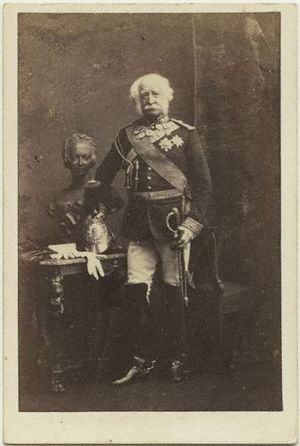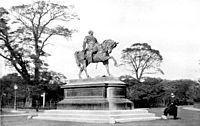Hugh Gough, 1st Viscount Gough facts for kids
Quick facts for kids
The Viscount Gough
|
|
|---|---|
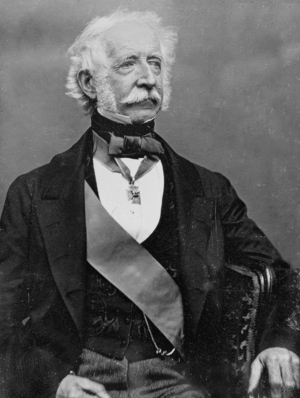
Daguerreotype of Gough wearing the Army Gold Cross, 1850
|
|
| Born | 3 November 1779 Woodstown, Annacotty, Kingdom of Ireland |
| Died | 2 March 1869 (aged 89) Booterstown, United Kingdom of Great Britain and Ireland |
| Buried |
Stillorgan, Ireland
|
| Allegiance | United Kingdom |
| Service/ |
British Army |
| Years of service | 1794–1849 |
| Rank | Field Marshal |
| Commands held |
|
| Battles/wars | |
| Awards | |
Field Marshal Hugh Gough, 1st Viscount Gough (born November 3, 1779 – died March 2, 1869) was an Irish officer in the British Army. He was a very important military leader.
Gough started his career as a young officer during the French Revolutionary Wars. He helped capture the Cape of Good Hope. Later, he led soldiers in the Peninsular War in Spain. He became famous for his bravery.
After that, he was the main commander of British forces in China during the First Opium War. Then, he became the top commander in India. He led British troops to victory against the Marathas and the Sikhs in several important wars. These included the First Anglo-Sikh War and the Second Anglo-Sikh War.
Contents
Early Military Life
Hugh Gough was born in Woodstown, Ireland. His father was also a military officer. Gough joined the army when he was just 14 years old, in 1793. He quickly moved up in rank.
In 1795, he took part in the capture of the Cape of Good Hope. This was during the French Revolutionary Wars. Later, he served in the West Indies. He also joined an expedition to Dutch Guiana in 1799. He became a captain in 1803.
Fighting in the Peninsular War
In 1809, Gough joined Sir Arthur Wellesley in Spain. This was during the Peninsular War. He led his battalion at the Battle of Talavera in July 1809. He was injured during this battle.
He also fought bravely at the Battle of Barrosa in 1811. His regiment captured a French Imperial Eagle, which was a great honor. He was promoted to lieutenant colonel. Gough was wounded again at the Battle of Nivelle in 1813. For his bravery, he received special honors.
Leading Forces in the East
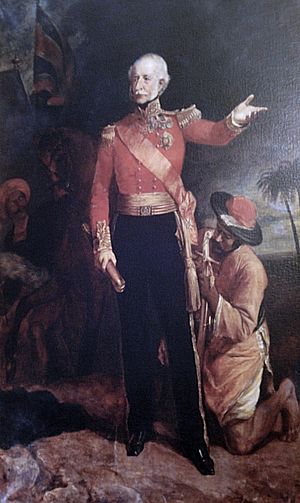
In 1839, Hugh Gough was chosen to be the commander-in-chief of British forces in China. This was during the First Opium War. He led successful attacks in places like Canton and Amoy in 1841. He also commanded troops at the Battle of Chapu and Battle of Chinkiang in 1842.
After the war ended with the Treaty of Nanking, Gough returned to India. He became a baronet, a special title. In 1843, he was made the top commander in India.
In December 1843, he led British forces against the Mahrattas. He defeated them in the Gwalior campaign. He also commanded troops in the First Anglo-Sikh War. He led battles like Battle of Mudki, Battle of Ferozeshah, and Battle of Sobraon. He was supported by Lord Hardinge, the governor-general. For his victories, he was given the title Baron Gough in 1846.
The Second Anglo-Sikh War began in 1848. Gough again led the British army. He fought at the Battle of Ramnagar and the Battle of Chillianwala. Some people criticized his tactics. However, he achieved a major victory over the Sikhs at the Battle of Gujarat in February 1849.
After this final victory, he returned to Ireland. He was given an even higher title: Viscount Gough in 1849. He retired from active service later that year. In 1862, he was promoted to field marshal, the highest rank in the British Army.
Death and Memorials
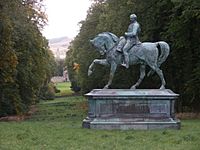
Field Marshal Hugh Gough passed away at his home in Booterstown, Ireland, on March 2, 1869. He was buried in Stillorgan.
After his death, people wanted to build a statue to honor him. An equestrian statue, showing him on a horse, was created by John Henry Foley. It was placed in Dublin's Phoenix Park in 1880. However, the statue was damaged many times. So, in 1990, it was moved to Chillingham Castle in England.
The metal for the statue came from cannons that Gough's forces captured in China and India.
Family Life
In 1807, Hugh Gough married Frances Maria Stephens. They had a family together. In 1852, he bought Lough Cutra Castle in Ireland. This became his family home.
Images for kids


